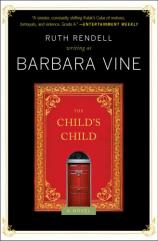The Child's Child
Review
The Child's Child
Ruth Rendell's novels written as Barbara Vine resist easy categorization. They are nothing like the police procedurals of her Inspector Wexford series, nor are they more traditional novels of suspense such as her stand-alone titles. Instead, they could best be described as portraits of the psyche, often the psyche of deeply troubled or damaged individuals. In THE CHILD'S CHILD, certainly one of Vine's best recent novels, she continues this inward exploration even as she uses the book to explore social issues over time.
"Comparing the experiences of John and Maud with those of Grace and Andrew more than 60 years later offers much scope for thought and consideration about how far society has come --- and how far we still have to go."
Framed as a novel-within-a-novel, THE CHILD’S CHILD opens in London in 2011, where sister and brother Grace and Andrew Easton live in their late grandmother's Victorian house, which they've inherited. The twenty-something siblings are close, and they find the cohabitation (each one occupies one-half of the sprawling mansion) pleasant. Grace has always wondered, though, what might happen when one of them wants to invite a boyfriend home to live with them. She finds out the answer to her question in short order, as Andrew begins spending more and more time with his boyfriend, James, who soon enough is practically living at the house.
Grace and James rub each other the wrong way right away. Grace, who's writing a dissertation on the literary treatment of unwed mothers and their illegitimate children in 19th- and early 20th-century novels, infuriates James, who argues that homosexuality, not illegitimacy, involves a much more serious and long-standing stigma, one that persists into the present day. James's point seems to be borne out when he and Andrew witness the beating death of a young friend of theirs outside a gay club. Grace, preoccupied by James's new role in her life as well as by her own unexpected pregnancy, turns her attention to reading a previously unpublished (and unpublishable) novel from the mid-20th century, one with eerie similarities to the situation in which she and her brother find themselves now.
The novel, also called The Child's Child, is set in the years before and during World War II. As it opens, a young man named John Goodwin is just starting out in a teaching career, swearing to himself that he will set aside his sexual relationship with another young man as "sinful." Meanwhile, his 15-year-old sister Maud has become pregnant after two encounters with a neighborhood boy. The siblings come from a solidly middle-class family, but that doesn't protect them from fierce shame and criticism. They concoct a plan to enable them to live their lives as quietly and positively as possible, by posing as husband and wife rather than brother and sister. But this deception feeds on itself and ultimately results in happiness for neither sibling. Vine's portrayal of Maud, in particular, shows how a single act of betrayal can result in a lifetime of resentment.
THE CHILD'S CHILD impressively situates these two social issues --- illegitimacy and homosexuality --- within specific historical context. Vine also shows how reaction to these ideas remains gendered and complex. Comparing the experiences of John and Maud with those of Grace and Andrew more than 60 years later offers much scope for thought and consideration about how far society has come --- and how far we still have to go.
Reviewed by Norah Piehl on December 7, 2012
The Child's Child
- Publication Date: October 8, 2013
- Genres: Fiction, Psychological Suspense, Psychological Thriller, Suspense, Thriller
- Paperback: 288 pages
- Publisher: Scribner
- ISBN-10: 1476704279
- ISBN-13: 9781476704272





